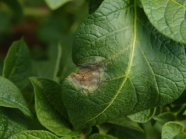Late Blight Control - Date and Product Strategy Must be Correct

late blight primary infections
When does late blight come? For potato grower, this question arises anew in every year.
Especially in years when the soil is strongly waterlogged for a longer period of time because of frequent rainfall from May till the middle of June it comes to early outbreaks of an epidemic. First symptoms usually appear in form of infestations of stems or of tops of the foliage. To avoid greater yield losses, an extensive use of fungicides is inevitable in most cases.
Basics about fungicide use
Using optimal spraying-techniques, contact preparations develop a dense coating on the leaf surface hindering fungal spores to penetrate into the plant tissue. These preparations have a prophylactic effect exclusively and can only prevent an infection if the first spraying and following sprayings are carried out according to schedule. That is, treatments must be carried out before infestation begins. Spraying has to be renewed in shorter time intervals (about seven days) in periods with high amounts of rain or in case of increasing growth rates, in longer time intervals (about 10 days) in phases of dryness or in case of no growth.
Local-systemic or systemic fungicides are absorbed by stem and leaf tissue in a short time (one to two hours). Therefore these preparations are less sensitive to rain and allow spraying at intervals from 10 to 14 days. Besides, these products also show an effect, when the fungus has already penetrated into plant tissue (prophylactic and curative effect). But an infection can only be stopped in an early phase (maximum 48 hours after its beginning). Infections dating back longer or visible infestations cannot be killed off any more by these preparations.
Local-systemic fungicides and especially systemic fungicides also have a good effect, if applied before infection. Because then the contact component, which is included in all products, is effective also. Applied before infection contact products gains full effect.
Carry out treatments in the morning hours
At which time of the day should fungicide treatments be carried out? This question is frequently asked by practitioners. The following is of importance: Systemic active substances must be taken up by the plant actively. Suffering from heat or drought stress potato plants are hardly able to do this. In periods of fine weather, the fungicides must therefore be applied in the early morning hours. In general this period can be regarded as optimal for contact fungicides, too. However in case of preparations with exclusive contact fungicide effect - they have to remain on the leaf surface - the early evening hours can also be considered. Around noon or in the afternoon the risk of wind drift is especially high (caused by air moving also from the soil surface upwards). For this reason no fungicide sprayings should be carried out at this time. Figure 1 gives an overview of the range of products.
Infected tubers are the starting point for the epidemic
Late blight (brown rot) is caused by the fungus Phytophthora infestans. During winter the pathogen survives in infested potato tubers. These are the cause of an epidemic in spring. Earlier studies carried out in cooperation with the chair of phytopathology of the TU Munich-Weihenstephan showed that in the past diseased tubers rotted in field stacks or in badly air-conditioned potato cellars and were picked out during seeds preparation in spring. In modern potato stocks with temperature control these tubers survive winter largely undamaged and are planted in spring. Particularly under humid soil conditions a severe primary infestation happens. If the soils can not be driven on in the early growing phase (May to the beginning of June) because of abundant rainfall (as for example in the year 2000 in the region Weser-Ems or in the area of Munich), a massive initial infestation has to be expected. Nowadays in case of humid spring weather primary infection pressure is far stronger than in times when field stack was the standard of potato storing. This phenonomen also explains the more frequent occurrence of symptoms on the stem compared to in the past.
Which fungicide for the first spraying?
For the first spraying, the use of a systemic product appears to be advantageous. Systemic fungicides penetrate into the stem and thus reduce the latent (not visible) infestation level. The best results are obtained, if a period of 10 to 14 days is between the fungicide spraying and the appearance of the first late blight symptoms. The infection pressure can be estimated approximately with the aid of forecasting procedures. If a low disease pressure is indicated contact fungicides are sufficient for the first treatment.
Which fungicides for the following treatments?
Here also the choice of product depends on the weather. And current infestations have to be taken into account as well. In case of low disease pressure (e. g. dry weather periods), contact fungicides can be used without risk. In case of changeable weather and of occurrences of stem infestation, local-systemic or systemic fungicides are advantageous. If the trafficability of the field is uncertain the use of these preparations is considerably more flexible because of longer spraying intervals. If a sporulating infestation occurs, so-called stopping-sprayings are advised. In this situation, a mixture of Fungicides with Cymoxanil as active ingredients and Fungicides with Fluazinam as active ingredients is recommended. An overview of the optimal positioning of the fungicides in depending on infection pressure and potato growth is given in Figure "Dates of Use for the Late Blight Fungicides".




